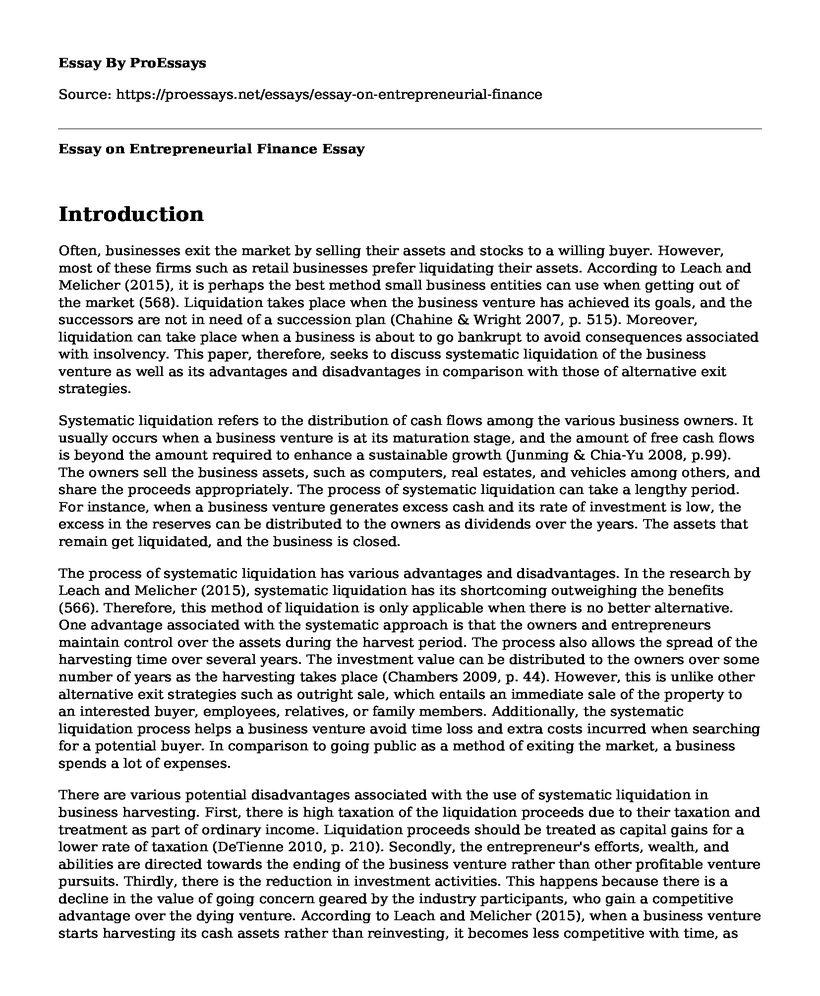Introduction
Often, businesses exit the market by selling their assets and stocks to a willing buyer. However, most of these firms such as retail businesses prefer liquidating their assets. According to Leach and Melicher (2015), it is perhaps the best method small business entities can use when getting out of the market (568). Liquidation takes place when the business venture has achieved its goals, and the successors are not in need of a succession plan (Chahine & Wright 2007, p. 515). Moreover, liquidation can take place when a business is about to go bankrupt to avoid consequences associated with insolvency. This paper, therefore, seeks to discuss systematic liquidation of the business venture as well as its advantages and disadvantages in comparison with those of alternative exit strategies.
Systematic liquidation refers to the distribution of cash flows among the various business owners. It usually occurs when a business venture is at its maturation stage, and the amount of free cash flows is beyond the amount required to enhance a sustainable growth (Junming & Chia-Yu 2008, p.99). The owners sell the business assets, such as computers, real estates, and vehicles among others, and share the proceeds appropriately. The process of systematic liquidation can take a lengthy period. For instance, when a business venture generates excess cash and its rate of investment is low, the excess in the reserves can be distributed to the owners as dividends over the years. The assets that remain get liquidated, and the business is closed.
The process of systematic liquidation has various advantages and disadvantages. In the research by Leach and Melicher (2015), systematic liquidation has its shortcoming outweighing the benefits (566). Therefore, this method of liquidation is only applicable when there is no better alternative. One advantage associated with the systematic approach is that the owners and entrepreneurs maintain control over the assets during the harvest period. The process also allows the spread of the harvesting time over several years. The investment value can be distributed to the owners over some number of years as the harvesting takes place (Chambers 2009, p. 44). However, this is unlike other alternative exit strategies such as outright sale, which entails an immediate sale of the property to an interested buyer, employees, relatives, or family members. Additionally, the systematic liquidation process helps a business venture avoid time loss and extra costs incurred when searching for a potential buyer. In comparison to going public as a method of exiting the market, a business spends a lot of expenses.
There are various potential disadvantages associated with the use of systematic liquidation in business harvesting. First, there is high taxation of the liquidation proceeds due to their taxation and treatment as part of ordinary income. Liquidation proceeds should be treated as capital gains for a lower rate of taxation (DeTienne 2010, p. 210). Secondly, the entrepreneur's efforts, wealth, and abilities are directed towards the ending of the business venture rather than other profitable venture pursuits. Thirdly, there is the reduction in investment activities. This happens because there is a decline in the value of going concern geared by the industry participants, who gain a competitive advantage over the dying venture. According to Leach and Melicher (2015), when a business venture starts harvesting its cash assets rather than reinvesting, it becomes less competitive with time, as other industry participants take advantage of the scenario (565). However, there are also disadvantages when using other business exist alternatives, such as loss of control over assets and loss productive employees.
Conclusion
In conclusion, it is clear that business harvesting and exiting can occur in various ways. These comprise of closing the business and distributing the investment value to the owners (systematic liquidation), a public offering that eventually leads to the sale of the owner's stock, and outright sale to a third party. Harvesting and existing of a business venture is a normal entrepreneurial activity, which allows the owners to make use of the monetary value of a business before indulging in other investment pursuits. Systematic liquidation, which is the most preferred process by the retail business, enables the ventures to share the proceeds acquired from the sale of assets equally.
Reference List
Chahine, S., Filatotchev, I. & Wright, M 2007, 'Venture capitalists, business angels, and performance of entrepreneurial IPOs in the UK and France', Journal of Business Finance & Accounting, 34 (3-4), pp.505-528.
Chambers, D 2009, 'Gentlemanly capitalism revisited: A case study of the underpricing of initial public offerings on the London stock exchange, 1946-'86', Economic History Review, 62 (S1), pp.31-56.
DeTienne, DR 2010, 'Entrepreneurial exit as a critical component of the entrepreneurial process: theoretical development,' Journal of Business Venturing, 25(2), pp.203-215.
Junming, H. & Chia-Yu, C 2008, 'An investment strategy based on the long-run performance of IPOs: Venture-backed and non-venture-backed firms,' Journal of Investing, 17 (4), pp.95-105.
Leach, JC. & Melicher, RW 2015, Entrepreneurial finance, Stamford, CT: Cengage Learning.
Cite this page
Essay on Entrepreneurial Finance. (2022, May 30). Retrieved from https://proessays.net/essays/essay-on-entrepreneurial-finance
If you are the original author of this essay and no longer wish to have it published on the ProEssays website, please click below to request its removal:
- Report on the Background to International Hotel Industry
- The Importance of Youth Entrepreneurship Essay
- Local and Global Business Opportunities for Countries Paper Example
- Auditing Robert's Dilemma Essay Example
- Midterm Assessment Critical Analysis on Entrepreneurship in the Ethnic Groups
- Fyre Media Fraud: McFarland's Unregistered Investment Scheme - Research Paper
- Paper Example on Lehman Brothers: Largest Bankruptcy in US History and Moral Problem of False Business







